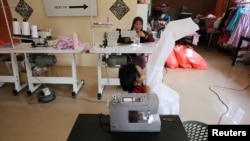The International Labor Organization says millions of people forced to work at home because of the coronavirus pandemic labor under poor and exploitative conditions.
Prior to the pandemic, an estimated 260 million people, representing 7.9 percent of global employment worked from home. The International Labor Organization expects this number now to be substantially higher.
The ILO says problems affecting workers often are invisible because they occur within the privacy of their own homes. The report finds homeworkers in low-and-middle income countries are most at risk. It notes about 90 percent, work informally within the confines of their homes. They produce goods that cannot be automated, such as garments, handicrafts, and assemble electronic items.
ILO senior economist and an author of the report, Janine Berg, tells VOA people churning out these traditional industrial products are unaccounted and easily exploitable.
“They do not have social protection coverage. They are more likely to suffer occupational safety and health risks. Some people are working in unsafe positions for example that can cause muscular skeletal disorders… Their earnings are below the minimum wage. Their working hours are very hard to predict. Sometimes they have periods of very intense work. Sometimes they have periods of no work. So, there is all this kind of instability,” said Berg.
In the global north, the report finds an increasing number of white-collar professionals working from home. They include teleworkers and home-based digital platform workers. Berg says they are usually worse off than those who work outside the home.
“Again, you are working from home. You have these challenges of social isolation. And then there is risks over time of a deterioration in working conditions even if you are a professional white-collar worker… And also because you are at home, you are less likely to be part of a trade union. You are less likely to have that kind of voice and dialogue that you would with management to kind of address some of these limitations in working conditions,” said Berg.
The ILO report says higher skilled professionals earn less on average than people working in an office. For example, it notes those working remotely earn on average 13 percent less in Britain, 22 percent less in the United States, and about 50 percent in India.
The ILO expects homeworking will continue to expand in post-COVID years. It says laws to better protect homeworkers must be enacted. It recommends the establishment of a labor registry of homeworkers and a system for monitoring their working conditions.




